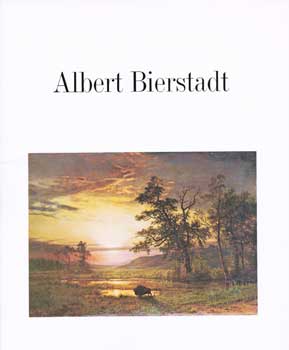Albert Bierstadt 1830 1902 (3 results)
Product Type
- All Product Types
- Books (2)
- Magazines & Periodicals
- Comics
- Sheet Music
- Art, Prints & Posters
- Photographs
- Maps
-
Manuscripts &
Paper Collectibles (1)
Condition
- All Conditions
- New
- Used
Binding
- All Bindings
- Hardcover
- Softcover
Collectible Attributes
- First Edition
- Signed
- Dust Jacket
- Seller-Supplied Images (1)
- Not Printed On Demand
Seller Location
Seller Rating
-
Albert Bierstadt, 1972.
Published by NY, NY: M. Knoedler & Co., Inc., 1972
Seller: Wittenborn Art Books, San Francisco, CA, U.S.A.
Manuscript / Paper Collectible
Condition: Good. Ephemera. 8vo. Soft Covers. 26 pp. Very Good.Color and black and white plates. Catalogue accompanies the exhibitions at September 19 - October 10, 1972.Text by Gordon Hendricks.
-
Storm in the Rocky Mountains, Mt. Rosalie
Published by Thomas McLean, London, 1869
Seller: Arader Galleries of Philadelphia, PA, Philadelphia, PA, U.S.A.
Book
No Binding. Condition: Very Good. Albert Bierstadt (1830-1902) was the nineteenth century chronicler par excellence of the American West. He undertook several trips to the Rocky Mountains and Yosemite Valley, where he made sketches of what would later become his most famous paintings. This brilliant chromolithograph depicts light breaking through a bank of thunderclouds above a valley. Indians on horseback dash down a mountainside toward an encampment of teepees along the valley. This image brilliantly captures American landscape painting of the period at its most heightened and rapturous. This chromolithograph was issued by Thomas McLean as a pair to The Rocky Mountains (Landers Peak). As many as 20 stones stones were used to capture the rich, sumptuous palette of the original painting, which now resides in the Brooklyn Museum of Art. (Nancy Anderson and Linda S. Ferber, Albert Bierstadt Art & Enterprise, pp. 274-275). Storm in the Rocky Mountains, Mt. Rosalie Published London, Thomas McLean, 1869 Chromolithograph by H.M. Long Image size: 18 3/4 x 32 1/4¿.
-
The Last of the Buffalo
Published by Goupil & Co., 1891
Seller: Arader Galleries of Philadelphia, PA, Philadelphia, PA, U.S.A.
Book
No Binding. Condition: Very Good. This monumental image, from one of Bierstadt's most famous paintings, illustrates a hunt taking place against a sweeping background of rolling prairie, which stretches to the mountains on the distant horizon. The composition is dominated by the figure of a mounted Indian hunter at right center, shown in the act of thrusting a lance into the side of a charging buffalo bull. Other dead or dying animals occupy the immediate foreground. The deep, lush contrasts of light and dark, along with the striking realism, draw a viewer into the drama of the hunt and the beauty of the wilderness. In addition to its dramatic impact, The Last of the Buffalo is essentially a nostalgic picture, in which Bierstadt declared his intention to "depict the cruel slaughter of a noble animal now almost extinct." Albert Bierstadt was the most successful artist of his time to capture America's hopes for future greatness in the untamed expanses of the West. A painter in the style of the Dusseldorf School, Bierstadt created images of grandeur which could not help but add to America's love of the mythic West and the spirit of adventure and discovery that it represented. Bierstadt's work was also a nationalist statement, as he managed to portray America as a place entirely unique from Europe. He conveyed the grandeur and drama of the western landscape as a definitive reply to all who viewed the United States as inferior, in scope and power, to Europe. The subject of Bierstadt's The Last of the Buffalo was one of especial popular appeal. Aside from the romantic excitement of the hunt imagery, the actual impending extinction of the buffalo was a pressing issue in the late 1880s. Bierstadt's image of vast herds and Indians armed with lances rather than rifles was pure nostalgia: nevertheless, viewers were quick to associate the subject with current events. The image served as Bierstadt's poignant rallying call for Americans to come to the defense of the buffalo, and his visual plea was arguably one of the most influential factors in creating popular sentiment in favor of their protection. To achieve his glorious compositions, Bierstadt combined both imaginary and actual elements to create scenes that were based as much in reality as in the ideal. While his works contained accurate information on flora and fauna, and detailed renderings of actual locations, Bierstadt's scenes primarily display a captivating sense of wonder. In educating the American public about the West, Bierstadt depicted a landscape which could rival any in Europe in magnificence, while conveying a distinctly American pioneer spirit. The beauty of Bierstadt's works arises not only from the clarity and skill of his rendering, but from his ability to understand and create images that embodied American popular thought and the compelling notion of Manifest Destiny. This powerful work, exemplary of Bierstadt's unique interpretation of western landscape, is in pristine condition. The Last of the Buffalo Photogravure: Goupil & Co., 1891 Signed in pencil, lower right Image size: 16 1/8¿ x 27 1/4¿.



